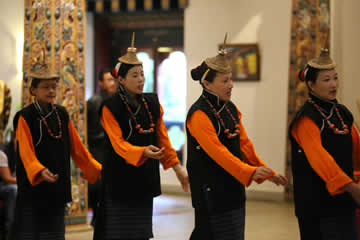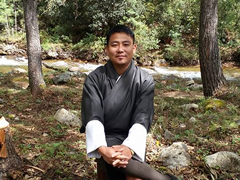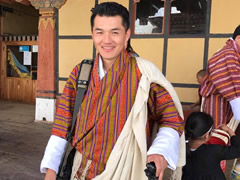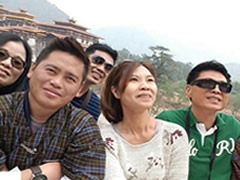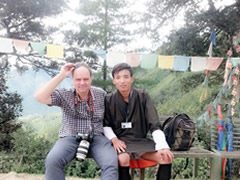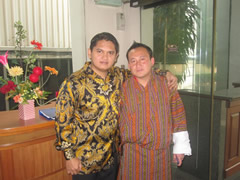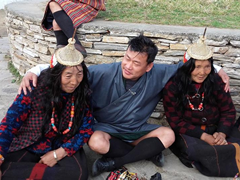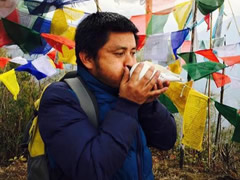- National Flags ( Gyedar)
The national flag of Bhutan was designed by azhi Choney Wangmo in the year 1947 and presented to third King of Bhutan. Later in 1949 3rd of Bhutan officially declared as the national flag of Bhutan coinciding with the signing of Indo- Bhutan treaty.
National Flag of Bhutan is divided diagonally with a white dragon in the center of the flag. The dragon symbolizes the purity. Holding Jewel symbolizes the strength of the country. The upper half is printed yellow symbolizing the secular power of the King. Orange below symbolizes the spiritual power of the Buddhism practice.
Bhutanese believe that thunder is actually the voices of the dragon roaring. Thus the dragon in the center of the flag or ‘Druk’ has deep association with the country itself.
- Mani Dhar
Mani Dhar has om ma ni padme hum printed on the prayer flags which belongs to the god of compassion (Avolokiteshwara ). There are two different types of mani dhar , one for death and one for we sentient beings.
- Sword : Represents Jampalyang or Manjushiri – the god of wisdom to cut the negativity and ignorance
- Khorolo: Represents the wheel of dharma symbolizes the Buddha’s teaching
- Flag pole : It should smooth and polished representing the god of compassion
- Prayer flags: Represents the three bodhisattvas : Jampalyang, Chenrizi and Chana Dorji.
- Base : are always strong and represents Chana Dorji – the god of power and energy
- Lhadhar
Lhadhar are very big and tall flag hosted in front of the Dzong’s, Monasteries, temples and noble families house. It also represent as national flags before 1949. Lhadhar doesnot have prayers printed but we will see the printed of four animal, like tiger, lion, Gauruda and dragon. It also has magical sword and victory banner on top, signifying the victory over the evils.
Significance of four animals:
- Tiger: Since tiger is believed to be the strongest animal so it shows the strength and no other animals can harm.
- Lion: Lion is considered as the king of animals and so he has power over the animals
- Gauruda : Gauruda is a mythical creatures believed to be have half human body and half bird. It tooks 500 years to hatch or incubate. When it was born it was much matured. He ate animals and cattle’s and use to bring sufferings and destructions to the people. No one could subdue Gauruda and later the god Indra subdue and converted Guruda into the protector deity. He got victory over the serpent world and that’s why we see Gauruda holding and eating snake.
- Dragon: Since we believe dragon as a mythical animal residing above the sky, he protects from any negativity like power from the sky, lightning, thundering, heavy rain and snow and iron from the sky.
- Chudhar
Any kinds of prayer flags near river or bridges are known as Chudhar. It is believed who ever crosses the bridges are blessed . It can also bless all creatures living in the river or oceans.
- Lungdar
When we do not have luck or thinking that you are going to compete with one, you consult astrologer and astrologer advice to host Lungdar to gain power and luck. Lungdar can be hosted without pole but they host by hanging through the long rope from one end to another. It has five different colors , white, yellow , red, blue and green representing five different elements. White – Air, Yellow – Earth, Red- Fire, Blue- Water and Green – Tree.
- Khadhar
Khadhar means "White Scarf" Ka means White and Dhar means Scraf. It looks like a long scarf and has auspicious symbols of eight lucky signs or different mantras inscribed or woven into the fabric.
The color white represents the sincerity of one's offering, with no negative thoughts or motives in mind.
Khadhar nowadays come in different shades of color. They are also used as a sign of recognition of one’s love or respect for another, such as teacher to students, master to disciples.
The offering of a scarf may seem to be a simple gesture, but it has its own significance and protocol, mostly governed by tradition.
We offer khadhar in various occasions like while receiving guest, during promotion celebration, death, newborn babies, while visiting Monateries and Dzongs and so on.
- Gyen dhar
Gyen dhar is placed upon the roof of the house with no mantra printed on it. We change the gyen dhar every year while making Tanks giving ceremony to our local deities.
- Tshendhar
Making offering to the forestry deities.


